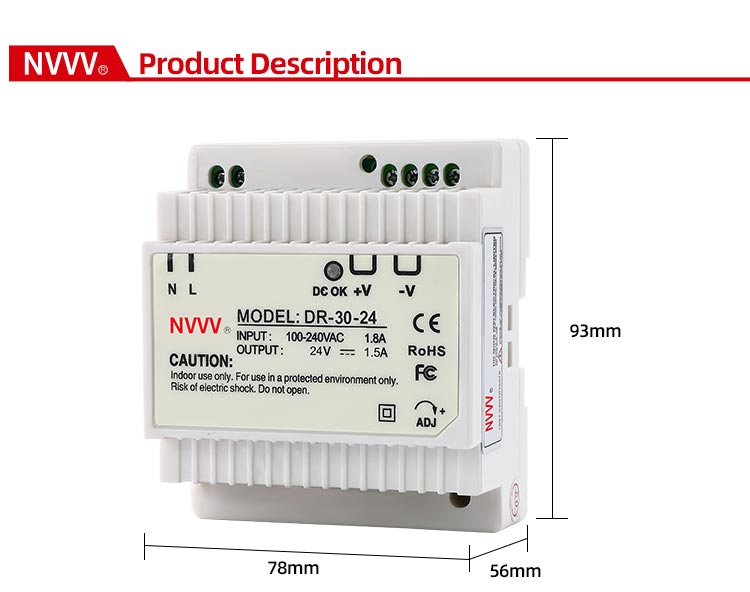What is the full form of SMPS?
The full name and definition of SMPS
SMPS is the abbreviation of "Switched-Mode Power Supply". A switch mode power supply is an electronic power supply that uses switching regulation technology to convert electrical energy into the required voltage and current for use by electronic devices. Unlike traditional linear power supplies, SMPS achieves voltage conversion and regulation through high-frequency switching and energy storage elements (such as inductors and capacitors).
Basic working principle of SMPS
The basic working principle of SMPS is to convert the input DC power into high-frequency AC power through high-frequency switching devices (such as transistors or MOSFETs), then step up or down the voltage through a transformer, and finally obtain a stable DC output through a rectification and filtering circuit. This process includes the following steps:
Input rectification and filtering: rectify the input AC power into DC power, and smooth the voltage through a filtering circuit.
High-frequency switching conversion: use high-frequency switching devices to convert DC power into high-frequency AC power. The switching frequency is usually between tens of kilohertz and hundreds of kilohertz.
Transformer isolation and regulation: adjust the voltage level and provide electrical isolation through a transformer.
Output rectification and filtering: Rectify high-frequency AC into DC and obtain a stable output voltage through a filter.
Feedback control: Monitor the output voltage through a feedback circuit and adjust the switching frequency or duty cycle to maintain a stable output.
Types of SMPS
Depending on the output voltage and conversion method, SMPS can be divided into the following types:
Buck Converter: Reduces the input voltage to the required output voltage. Suitable for applications that require lower voltages.
Boost Converter: Increases the input voltage to the required output voltage. Suitable for applications that require higher voltages.
Buck-Boost Converter: Can operate with an output voltage higher or lower than the input voltage, providing greater flexibility.
Flyback Converter: Provides isolation through transformer coupling and is suitable for low-power applications.
Forward Converter: Similar to the flyback type, but different in the energy transmission method, suitable for medium-power applications.
Advantages of SMPS
High efficiency and energy saving: Since the switching device works in the full conduction and full cut-off states, the switching loss is low, so the efficiency is high, usually above 80%.
Small size and light weight: Due to the use of high-frequency transformers and energy storage elements, the size and weight can be greatly reduced, which is convenient for integration in portable devices.
Wide voltage input range: It can adapt to a wider input voltage range and is suitable for grid voltage standards around the world.
Good output stability: The output voltage can be precisely adjusted through feedback control, and the anti-interference ability is strong.
Application of SMPS
Computers and servers: switching power supply is the core part of the computer power supply, responsible for providing stable DC power.
Communication equipment: used for power supply of base stations, routers, switches and other equipment.
Consumer electronics: such as TVs, audio, game consoles, etc., SMPS provides the required DC power.
Industrial equipment: such as CNC machine tools, industrial control systems, etc., SMPS is used to provide stable power support.
Electric vehicle charger: Provides efficient power conversion and charging control for electric vehicles.
Comparison of SMPS and Linear Power Supplies
Efficiency: SMPS is usually much more efficient than linear power supplies, especially in high-power applications, where the heat loss of linear power supplies increases significantly, while SMPS can effectively reduce this loss.
Size and weight: Since no large transformer and heat sink are required, SMPS is smaller in size and weight, making it more suitable for portable devices.
Thermal management: SMPS generates less heat, so the requirements for heat dissipation are lower, which can simplify the design and reduce costs.
Complexity: The design and manufacture of SMPS are relatively complex, and switching noise and electromagnetic interference issues need to be considered, while linear power supplies are relatively simple.
Cost: In low-power applications, linear power supplies may have more cost advantages, but as the power increases, SMPS is more cost-effective.
Design challenges of SMPS
Electromagnetic interference (EMI): High-frequency switching action will generate electromagnetic interference, which may affect the normal operation of other electronic devices, so shielding, filtering and other measures are needed to suppress it.
Thermal design: Although SMPS has high efficiency, the heat dissipation system still needs to be properly designed to ensure that the device operates within a safe temperature range.
Reliability: The quality of high-frequency switching devices and energy storage components has a great impact on the reliability of switching mode power supply, so high-quality components need to be selected.
Feedback control: Design high-precision feedback control circuits to ensure the stability and transient response of the output voltage.
Future development of SMPS
With the trend of miniaturization and portability of electronic devices, the demand for SMPS will continue to grow. Future development directions include:
Higher efficiency: Improve conversion efficiency and reduce power consumption through the application of new materials and new topologies.
Smaller size: Use higher frequency switching devices and integrated design to further reduce the volume.
Intelligent control: Introduce intelligent control algorithms to achieve higher-precision voltage regulation and load management.
Green and environmental protection: Develop lead-free and halogen-free power supplies that meet environmental standards to reduce the impact on the environment.
Wider application: Expand to more emerging fields, such as wearable devices, Internet of Things devices, etc.
Conclusion
SMPS is an indispensable power conversion device in modern electronic devices. It is widely used in various industries for its high efficiency, lightness and stability. As technology continues to advance, SMPS will play a more important role in future electronic products and contribute to the realization of green and efficient power management.











